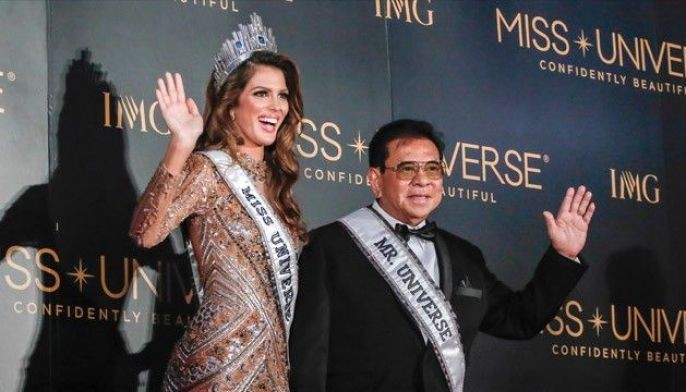Lacoste looks beyond the croc

When doing fashion interviews you rarely want to rip the clothes off someone’s back, especially if that someone heads a legendary brand, but that was precisely what I wanted to do upon meeting Christophe Chenut, the CEO of Lacoste.
It wasn’t the strength of his mojo, though he certainly had presence; it was his white polo shirt, which bore Lacoste’s famous emblem with a twist — instead of a lone crocodile, Chenut sported a whole pack of them converging on the left side of his chest — Lacoste’s limited-edition collaboration with the Brazilian Campana brothers.
It’s the way they mix history with modernity that makes Lacoste such an iconic brand. You would have to have lived under a pretty big rock to have missed those croc-crested cotton pique polo shirts that became ubiquitous on tennis courts and golf courses in the Philippines.
 Porcelain complexion: Today, Lacoste shirts come in cutting-edge designs — the latest is a sculpture made of Ming porcelain shards by artist Li Xiaofeng, printed versions of which are now avail-able in Store Specialists, Inc.’s local Lacoste boutiques.
Porcelain complexion: Today, Lacoste shirts come in cutting-edge designs — the latest is a sculpture made of Ming porcelain shards by artist Li Xiaofeng, printed versions of which are now avail-able in Store Specialists, Inc.’s local Lacoste boutiques. Today, those shirts come in myriad colors and cutting-edge designs — the latest is a sculpture made out of Ming porcelain shards by artist Li Xiaofeng — printed versions of which are now available in Store Specialists, Inc.’s local Lacoste boutiques —but their essential shape and DNA remain the same.
“Every day we have to keep one eye on the past and one on the future,” says Chenut. “We have a very strong heritage and patrimony, and have worked the last three years to identify all the collections to create an incredible database of pictures.”
The result is a comprehensive brand book containing all of Lacoste’s clothes, history and heritage, which they present to all potential licensees creating other aspects of the lifestyle brand, from apparel, shoes, and eyewear to watches and leather goods.
“Every year we have a partnership with a designer, architect, someone from another industry that brings new ideas for a collection or limited edition but respecting the clothes,” Chenut says. “We need to do that regularly to keep the brand alive and it works very well because so many creative people love Lacoste.”
One such person is Portuguese designer Felipe Oliveira Baptista, Lacoste’s new creative director, who replaced Christophe Lemaire last September when Lemaire left for Hermès. Baptista had grown up knowing the brand, and his vision squared almost 100 percent with Lacoste’s heritage of clear lines and classic style.
 Close-up of the Li Xiaofeng design for Lacoste
Close-up of the Li Xiaofeng design for Lacoste “Others were more into general sportswear, a more American way of seeing the sportswear, but Felipe made the best presentation because he was very much into the clothes and heritage of the brand,” notes Chenut.
Another deciding factor was that Baptista specializes in womenswear, a segment that Lacoste plans to develop in a major way. The designer will show his first collection for Lacoste at New York Fashion Week in September.
The polo shirt invented by Rene Lacoste in 1927 remains the brand’s icon and bestselling product, however. The No. 1 tennis player in the world from 1926 to 1927, Lacoste fashioned a lightweight mesh garment that afforded him ease of movement on the tennis courts —a garment that was soon adopted by his Davis Cup teammates.
Today, the polo shirt accounts for 30 percent of Lacoste’s worldwide turnover of 1.5 billion euros (50 to 60 percent of the Philippines’), and is classified into eight different categories, from Stretch to Vintage to the historical L.12.12, so named because it was the 12th prototype of the shirt that Rene Lacoste was satisfied with.
So successful has the crocodile logo been that “it was time we gave back to the crocodile what he has given to us,” says Chenut. Hence Lacoste is the first company to join Save Your Logo, a campaign launched by the World Bank and other international institutions that encourages companies using animal logos to help save the endangered among those species from extinction.
“When they promoted their ideas in their press conference, they used the example of Lacoste and the crocodile,” Chenut says. “Thanks to that, we discovered the program and found the idea fantastic and very well adapted to us, because no other brand is as related to an animal as we are.”
 Portuguese designer Felipe Oliveira Baptista, Lacoste’s new creative director
Portuguese designer Felipe Oliveira Baptista, Lacoste’s new creative director Lacoste currently donates 500,000 euros a year to help local associations in different countries prevent species of crocs numbering less than 100 from disappearing. They started by creating a protected zone for the gharial crocodile of Nepal’s Gange River, continued with Colombia’s Orinoco croc, and have three new projects for 2011: to save the Chinese and Florida alligators and, most significantly, the Philippine crocodile of Northern Luzon.
“There are less than 100 of this crocodile and there are more in the Melbourne Zoo. So we are partnering with that zoo to give money for the specie and the 4 Cs program: Cash for Communities Conserving Crocodiles.”
Financial rewards that provide education and training are given to local communities and groups, like our Mabuwaya Foundation, that are able to expand the crocodile population. “We also have the patronage of government bodies like the DENR, but all in all, it benefits local communities in North Luzon,” adds Jerome Bachasson, regional director for Lacoste Asia-Pacific.
It’s a love affair not just between Lacoste and its logo but also between Lacoste and the Philippines, where the brand has flourished for 20 years now. “The feeling I have is that brand awareness and image is so strong in this country that every new product and category we could put on the market would be a success,” says Chenut. “People love the brand and are waiting for Lacoste ideas. It’s nice to see that in Manila.”
“The brand has been here for quite a long time now and has come to symbolize a lot of positive things for Filipino consumers,” concurs Gina Dagdag, Lacoste’s merchandising manager. “They regard it as the perfect epitome of style and quality, and this is why a lot of customers aspire to the brand.”
* * *
In the Philippines, Lacoste is exclusively distributed by Stores Specialists, Inc. and is available at Rustan’s Department Store and Lacoste boutiques.



















